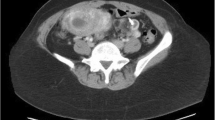Abstract
Secondary hyperthyroidism can often complicate gestational trophoblastic disease, a malignant uterine cancer. We report here the perioperative management of hyperthyroidism due to hydatidiform mole. A 53-year-old woman underwent emergency surgery due to suspicion of hydatidiform mole. Tachycardiac atrial fibrillation was detected by electrocardiography at the preoperative examination. No abnormalities were found in blood count, coagulation, biochemical tests, chest radiographs, or respiratory function. General anesthesia with nitrous oxide, oxygen, and sevoflurane, combined with fentanyl and 1% mepivacaine, was administered intermittently from an epidural catheter. Intraoperative events included hypotension and tachycardia, although in general, tachycardia was prevented with antiarrhythmic agents and transfusion with a plasma expander and crystalloid fluid. Hyperthyroidism was highly suspected from the patient’s clinical course and was confirmed by high levels of preoperative serum free triiodothyronine (T3) and thyroxine (T4). The patient became euthyroid within a few days after mole evacuation and did not require an antiarrhythmic agent after her return to the inpatient ward.
Similar content being viewed by others
References
Rajatanavin R, Chailurkit LO, Srisupandit S, Tungtrakul S, Bunyaratvej S. Trophoblastic hyperthyroidism: clinical and biochemical features of five cases. Am J Med. 1988;85:237–241.
Kenimer JG, Hershman JM, Higgins HP. The thyrotropin in hydatidiform moles is human chorionic gonadotropin. J Clin Endocrinol Metab. 1975;40:482–491.
Hershman JM. Hyperthyroidism induced by trophoblastic thyrotropin. Mayo Clin Proc. 1972;47:913–918.
Miyai K, Tanizawa O, Yamamoto T, Azukizawa M, Kawai Y. Pituitary-thyroid function in trophoblastic disease. J Clin Endocrinol Metab. 1976;42:254–259.
Narasimhan KL, Ghobrial MW, Ruby EB. Hyperthyroidism in the setting of gestational trophoblastic disease. Am J Med Sci. 2002;323:285–287.
Sowers JR, Hershman JM, Carlson HE, Pekary AE. Effect of human chorionic gonadotropin on thyroid function in euthyroid men. J Clin Endocrinol Metab. 1978;47:898–901.
Lok CA, Zürcher AF, van der Velden J. A case of a hydatidiform mole in a 56-year-old woman. Int J Gynecol Cancer. 2005;15:163–166.
Nagataki S, Mizuno M, Sakamoto S, Irie M, Shizume K. Thyroid function in molar pregnancy. J Clin Endocrinol Metab. 1977;44:254–263.
Kim JM, Arakawa K, McCann V. Severe hyperthyroidism associated with hydatidiform mole. Anesthesiology. 1976;44:445–448.
Solak M, Aktürk G. Spinal anesthesia in a patient with hyperthyroidism due to hydatidiform mole. Anesth Analg. 1993;77:851–852.
Erturk E, Bostan H, Geze S, Saracoglu S, Erciyes N, Eroglu A. Total intravenous anesthesia for evacuation of a hydatidiform mole and termination of pregnancy in a patient with thyrotoxicosis. Int J Obstet Anesth. 2007;16:363–366.
Nishiyama T. Hemodynamic and catecholamine response to a rapid increase in isoflurane or sevoflurane concentration during a maintenance phase of anesthesia in humans. J Anesth. 2005;19:213–227.
Segawa H, Mori K, Murakawa M, Kasai K, Shirakami G, Adachi T, Arai T. Isoflurane and sevoflurane augment norepinephrine responses to surgical noxious stimulation in humans. Anesthesiology. 1998;89:1407–1413.
Mustola ST, Baer GA, Metsä-Ketelä T, Laippala P. Haemodynamic and plasma catecholamine responses during total intravenous anaesthesia for laryngomicroscopy. Thiopentone compared with propofol. Anaesthesia. 1995;50:108–113.
Duggal J, Singh S, Kuchinic P, Butler P, Arora R. Utility of esmolol in thyroid crisis. Can J Clin Pharmacol. 2006;13:e292–e295.
Pandey CK, Raza M, Dhiraaj S, Agarwal A, Singh PK. Rapid preparation of severe uncontrolled thyrotoxicosis due to Graves’ disease with iopanoic acid-a case report. Can J Anaesth. 2004;51:38–40.
Author information
Authors and Affiliations
About this article
Cite this article
Matsumoto, S., Shingu, C., Hidaka, S. et al. Anesthetic management of a patient with hyperthyroidism due to hydatidiform mole. J Anesth 23, 594–596 (2009). https://doi.org/10.1007/s00540-009-0809-5
Received:
Accepted:
Published:
Issue Date:
DOI: https://doi.org/10.1007/s00540-009-0809-5




